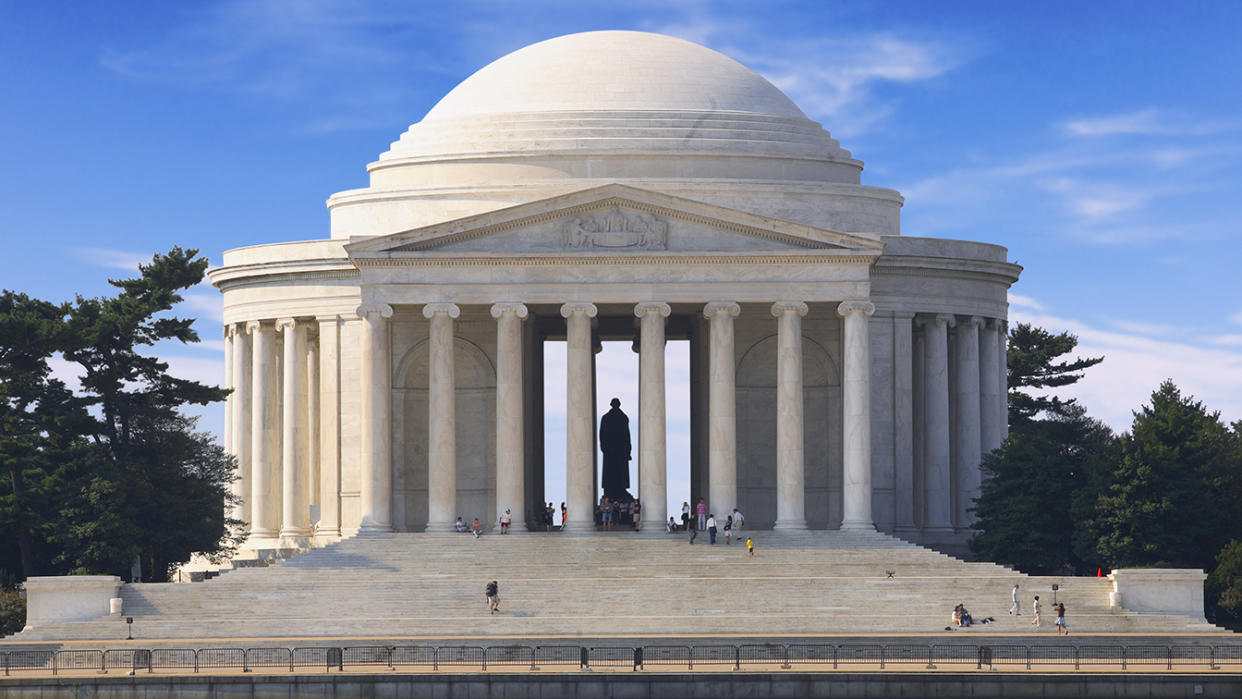From Thomas Jefferson's own family, a call to take down his memorial

A direct descendant of Thomas Jefferson has called for the memorial to the third president to be removed from Washington, D.C.
Writing in the New York Times Monday morning, Lucian K. Truscott IV says his ancestor’s former estate at Monticello is enough of a tribute and that the Jefferson Memorial, located next to the Tidal Basin in the nation’s capital, should be replaced with a statue honoring the abolitionist hero Harriet Tubman.
“The memorial is a shrine to a man who during his lifetime owned more than 600 slaves and had at least six children with one of them, Sally Hemings,” Truscott writes. “It’s a shrine to a man who famously wrote that ‘all men are created equal’ in the Declaration of Independence that founded this nation — and yet never did much to make those words come true. Upon his death, he did not free the people he enslaved, other than those in the Hemings family, some of whom were his own children. He sold everyone else to pay off his debts.”
In the piece, Truscott argues that Monticello serves as an “almost perfect memorial” to the nation’s third president. In his opinion, Monticello notes Jefferson’s major contributions to the creation of the United States — including the Declaration of Independence — but also includes his history as a slave owner, or, as Truscott writes, “it reveals him with his moral failings in full, an imperfect man, a flawed founder.”
“I am the sixth-generation great-grandson of a slave owner,” Truscott continues. “My cousins from the Sally Hemings family are also the great-grandchildren of a slave owner. But the difference is that our great-grandfather owned their great-grandmother. My family owned their family. That is the American history you will not learn when you visit the Jefferson Memorial. But you will learn it when you visit Monticello: There’s now an exhibit of Sally Hemings’s bedroom in her cavelike living quarters in the south wing, a room my brother and I used to play in when we were boys.”
Truscott is a novelist and columnist for Salon whose grandfather was a general during World War II.

In a July feature in Smithsonian Magazine, another Jefferson descendant, Shannon LaNier, was photographed in the same style as his sixth great-grandfather but opted not to wear a wig because he “didn’t want to become Jefferson.”
“He was a brilliant man who preached equality, but he didn’t practice it,” said LaNier, who is descended from Jefferson and Hemings. “He owned people. And now I’m here because of it.”
The discussion around the monument comes amid a national conversation in the wake of George Floyd’s death about who should be honored with statues, memorials and buildings named after them. A number of Confederate monuments, and statues honoring Christopher Columbus, have been removed by either local officials or protesters, but there is a trickier discussion around Founding Fathers who were also slave owners, including Jefferson and George Washington. A visit by President Trump to Mount Rushmore, which features sculptures depicting both Washington and Jefferson, drew attention to the South Dakota monument that’s located on Lakota land.
A statue of Theodore Roosevelt, the nation’s 26th president, is set to be removed from outside New York City’s American Museum of Natural History — not as a commentary on Roosevelt but owing to how it depicts the two figures flanking him, a Native American man and a Black man. The museum said it still planned to honor Roosevelt, whom it called a “a pioneering conservationist.”
“The world does not need statues, relics of another age, that reflect neither the values of the person they intend to honor nor the values of equality and justice,” said Theodore Roosevelt IV, a great-grandson and museum trustee. “The composition of the Equestrian Statue does not reflect Theodore Roosevelt’s legacy. It is time to move the statue and move forward.”
In recent weeks, Trump has attempted to make protecting monuments a top issue, signing one executive order in an attempt to further criminalize defacing or toppling them and another one to create a national statue garden of “the greatest Americans to ever live.” Trump has defended monuments to the Confederacy and has balked at renaming U.S. military bases that honor Confederate officers.
Truscott has a replacement in mind for the Jefferson Memorial, suggesting a Union Army veteran and the woman whose portrait was selected to replace Andrew Jackson on the $20 bill until the Trump administration decided otherwise.
“It’s time to honor one of our founding mothers, a woman who fought as an escaped slave to free those still enslaved, who fought as an armed scout for the Union Army against the Confederacy — a woman who helped to bring into being a more perfect union after slavery, a process that continues to this day. In Jefferson’s place, there should be another statue. It should be of Harriet Tubman,” Truscott said. “To see a 19-foot-tall bronze statue of a Black woman, who was a slave and also a patriot, in place of a white man who enslaved hundreds of men and women is not erasing history. It’s telling the real history of America.”
_____
Read more from Yahoo News:



